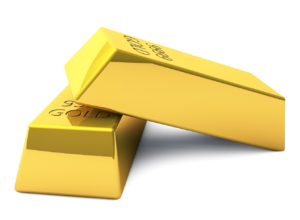
Gold is one of the most popular and oldest stores of value in the world. Here are ten reasons you might want to add gold to your investment portfolio.
No one can print gold
No government, company, or individual can produce gold at will.
Gold is scarce because it’s so difficult to find and extract from the earth.
And unlike fiat currencies which are printed endlessly, when governments print more money they pay for it by issuing debt (IOUs), thus creating inflationary pressures that undermine confidence in the value of paper money and often lead to economic crises.
Gold is Reliable
Gold’s scarcity and resistance to manipulation means that it acts as a reliable store of value, retaining its purchasing power over the long term.
Commodities like copper and oil, which are used in industrial production can also provide protection against inflation (commodities are sometimes called “real assets” to distinguish them from financial assets).
But their industrial use means they have many other uses, which can reduce demand and thus keep prices lower, whereas gold is almost exclusively a monetary asset.
Gold keeps its value
We know that paper money doesn’t hold its value.
If you’re saving for your kids’ education or to buy a house in ten years, you’re probably going to be disappointed, because the purchasing power of what you save is likely to have declined significantly.
Gold is different, it has retained its value over thousands of years, so it can act as your insurance against the failure of paper money systems.
Gold pays no interest
When you own gold, you don’t have to pay interest or dividends to anyone.
Many countries which hold their reserves in paper money are paying negative real rates of interest on their debt, because inflation is higher than the returns investors can earn by lending them money.
The opportunity cost of holding gold is zero, which makes it an ideal hedge against other assets with a return which is either negative, or carries an exorbitant cost.
Gold is a liquid store of value
In times of economic stress, investors flock to liquidity and safety, leading to higher prices for gold as well as lower yields on bonds and cash.
In 2011-12 we saw this dynamic in action as trillions of dollars flowed into gold ETFs and other bullion-related vehicles.
Gold is incredibly liquid. In fact, it’s the only real money that can be exchanged instantly for goods and services without reference to a third party, since its supply is finite and cannot be printed at will by central banks.
The SPDR Gold Trust GLD trades over 100 million ounces a day in large volumes, making it one of the most liquid assets in the world.

Gold is not correlated with other assets
One of the most valuable characteristics of an asset is the ability to “hedge” or offset risk in your portfolio.
Gold has a low or even negative correlation with other assets, so it reduces volatility while preserving wealth during market storms.
This makes it ideal for long-term savings since you can keep more of what you have earned through good times and bad.
Gold is not correlated with paper money
Gold isn’t correlated with the value of currencies, which means it’s a great diversifier.
If the US dollar rises 10% against the euro for example, gold is likely to hold its value or even increase slightly because it doesn’t move in line with other assets.
This phenomenon gives gold an advantage over commodities like oil, which sometimes rises when the dollar is strong, but more often falls along with other assets.
Gold has been money for thousands of years
Gold’s ability to retain its value over long periods explains why it’s been used as a store of value for thousands of years.
From the Roman Empire to today’s world, civilizations have adopted gold as their preferred commodity to back paper money and coinage.
Governments like gold because it can’t be printed…this makes it less likely to cause inflation when they need to finance war or welfare spending through borrowing (in other words, “printing money”).
Gold does not have to be recycled
Gold is a physical commodity that doesn’t need to be “recycled” like base metals because we don’t “use it up.”
The supply of gold increases very slightly each year due to mining and recycling, but is dwarfed by the massive amounts of gold bought and sold in the markets every day.
Gold isn’t burned, eaten or thrown away…it just sits there saving wealth for its owners.
Gold is not subject to technological disruption
Gold can’t be printed or digitally transferred like paper money or electronic data.
Governments cannot control gold, it is becoming a popular alternative to paper money and digital data in the event of an economic collapse.
In the event of a financial crisis, gold is an excellent means of preserving wealth.
In other words, it retains its value, unlike paper money or electronic data which could be inflated away to nothing by governments under pressure from banks.
Below are the Top 4 Precious Metal firms that we have chosen, as being amongst the most reputable Gold IRA companies in the industry.
Click here to read our reviews

|
The Bottom Line
Gold is worth more than its weight in gold.
It’s an investment that pays off and it will never lose value due to inflation.
The price of gold may fluctuate, but the metal itself has been used as a form of currency for thousands of years because people trust it and know that they can exchange their wealth into something tangible even if there’s no other money available.
So whether you’re looking to invest for retirement or just want to secure your personal safety net, adding some precious metals like gold coins, silver bars, platinum bullion or palladium rounds to your portfolio might be a good idea.



